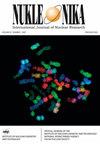高温反应堆材料辐照用ISHTAR恒温装置的初步计算和实验设计研究
IF 0.3
4区 物理与天体物理
Q4 CHEMISTRY, INORGANIC & NUCLEAR
引用次数: 3
摘要
摘要高温反应堆辐照系统(ISTAR)恒温装置将用于在与高温反应堆(HTR)中普遍存在的条件相对应的条件下辐照先进的堆芯材料样品:这些条件包括在氦气环境中延伸至1000°C的稳定温度。已经进行了与设计相关的计算和实验研究,证明了在保持MARIA研究反应堆安全极限的同时,在钻机内满足这些条件的可能性。结果是将在MARIA反应堆中实施的恒温装置设计。适当的辐照温度将通过将电加热与控制系统、伽马加热和具有精确设计厚度的氦绝缘间隙相结合来实现。ISHTAR钻机将放置在反应堆水池中的垂直辐照通道内。作为GOSPOSTRATEG计划的一部分,该装置正在国家核研究中心核设施运营部从头开始开发。本文章由计算机程序翻译,如有差异,请以英文原文为准。
Preliminary computational and experimental design studies of the ISHTAR thermostatic rig for the high-temperature reactors materials irradiation
Abstract The Irradiation System for High-Temperature Reactors (ISHTAR) thermostatic rig will be used to irradiate advanced core material samples in conditions corresponding to those prevailing in the high-temperature reactors (HTRs): these conditions include a stable temperature extending up to 1000°C in the helium atmosphere. Computational and experimental studies concerning the design have been conducted, proving the possibility of these conditions’ fulfillment inside the rig while maintaining the safety limits for MARIA research reactor. The outcome is the thermostatic rig design that will be implemented in the MARIA reactor. Appropriate irradiation temperature will be achieved by a combination of electric heating with the control system, gamma heating, and a helium insulation gap with precisely designed thickness. The ISHTAR rig will be placed inside the vertical irradiation channel, which is located in the reactor pool. The device is being developed from scratch at the Nuclear Facilities Operation Department of the National Centre for Nuclear Research as a part of the GOSPOSTRATEG programme.
求助全文
通过发布文献求助,成功后即可免费获取论文全文。
去求助
来源期刊

Nukleonika
物理-无机化学与核化学
CiteScore
2.00
自引率
0.00%
发文量
5
审稿时长
4-8 weeks
期刊介绍:
"Nukleonika" is an international peer-reviewed, scientific journal publishing original top quality papers on fundamental, experimental, applied and theoretical aspects of nuclear sciences.
The fields of research include:
radiochemistry, radiation measurements, application of radionuclides in various branches of science and technology, chemistry of f-block elements, radiation chemistry, radiation physics, activation analysis, nuclear medicine, radiobiology, radiation safety, nuclear industrial electronics, environmental protection, radioactive wastes, nuclear technologies in material and process engineering, radioisotope diagnostic methods of engineering objects, nuclear physics, nuclear reactors and nuclear power, reactor physics, nuclear safety, fuel cycle, reactor calculations, nuclear chemical engineering, nuclear fusion, plasma physics etc.
 求助内容:
求助内容: 应助结果提醒方式:
应助结果提醒方式:


